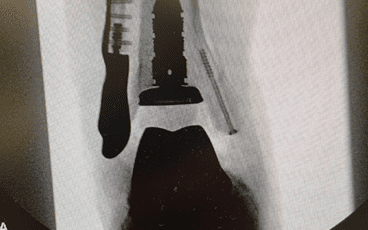Ankle replacement surgery is usually a last choice for doctors; however, there are a few types of patients that are good candidates. Typical recipients of ankle replacements have a joint that has been severely damaged by injury, osteoarthritis, or rheumatoid arthritis. Patients, who have had a prior ankle surgery, like ankle fusion surgery, are also candidates for ankle arthroplasty. Older patients tend to be the better candidates because they are usually have decreased activity levels. Ankle replacements can wear out; so the less active the patient, the better an ankle replacement will perform.
How The Surgery Is Performed
An ankle replacement surgery involves many steps for the surgeon so most patients are under general anesthetic. Once under anesthesia the surgeon will begin by removing the damaged areas of bone and cartilage. Then, to accommodate the replacement joint, the surgeon will need to reshape the bones that comprise the ankle. These bones make up the bones in the lower leg, the tibia and fibula, and the bone in the top of the foot called the talus. The surgeon then attaches the replacement joint to the ankle. After the joint is replaced the tendons are reattached and the incision is stitched up.
Recovery After The Surgery
Ankle replacement surgery usually can entail a one to three night stay at the hospital and the use of a cast or splint. For six weeks, and potentially longer, patients are required to stay completely off the ankle. The surgeon usually prescribes three months of physical therapy, and in some cases it can continue 2-4 months or longer. Even though the therapy can last a long time, it is probably one of the most beneficial things you can do to recover from the surgery.
Potential Outcomes Of Ankle Replacement Surgery
When an ankle arthroplasty is successful it can achieve great results. The pain that is present in the ankle can be completely relieved and the joint’s mobility can be maintained. The ankle joint undergoes lots of stress through the normal motion of walking, while supporting the full weight of the person’s body. Joint replacements are mechanical devices and will wear out over time. The length of time an ankle replacement will last depends on the patients health, how severely the ankle was damaged prior to surgery, and most importantly the patients activity level. Currently, about 80% of total ankle replacements will last 10 years or longer.
If you’re experiencing persistent pain in your ankle Schedule online now with one of our orthopedic physicians. The surgeons at the Illinois Bone and Joint Institute will work hard to ensure that you get the best possible outcome from your surgery. IBJI is your best choice for orthopedic care and joint arthroplasty.
*This content is for information only and is not intended to replace the diagnosis, treatment, or medical advice from your treating healthcare professionals. The content does not provide medical advice, does not constitute the practice of medicine or other healthcare professional services, and does not create a doctor-patient relationship. You should not rely on this information as a substitute, nor does it replace professional medical advice, diagnosis, or treatment. If you have concerns or questions, seek the advice of your healthcare professionals. If you think you may have a medical emergency, call your doctor or 911 immediately. Do not rely on electronic communications or communicate through this website for immediate, urgent medical needs. This website is not designed to facilitate medical emergencies. The use of the information is at the reader’s own risk. The links are provided for information and convenience only. We cannot accept responsibility for the sites linked or the information found here. A link does not imply an endorsement of a site.




